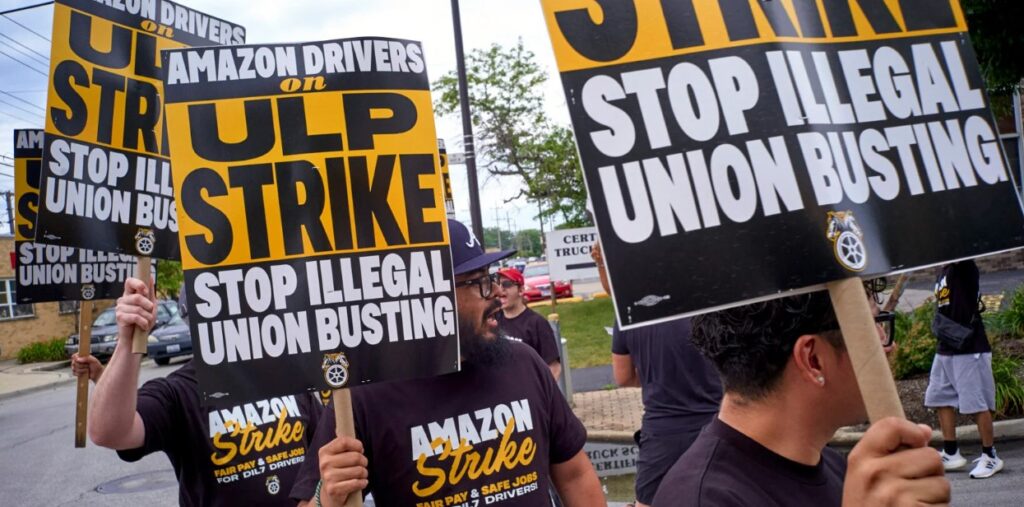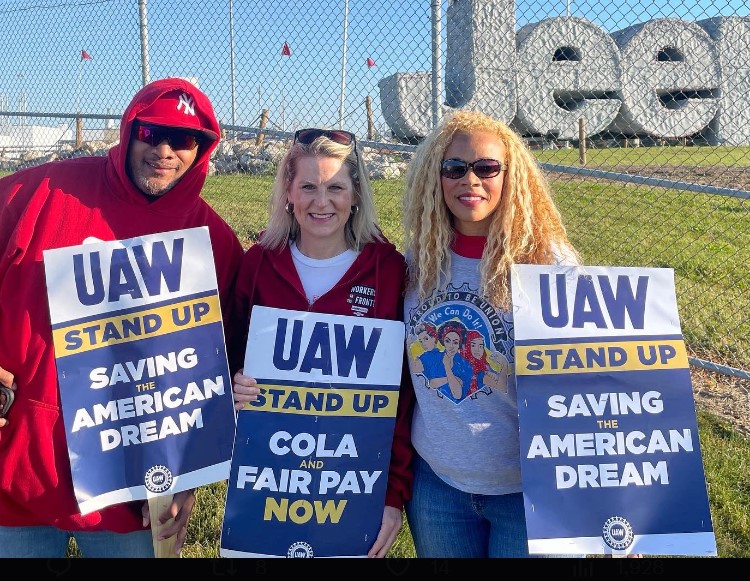By Richard Mellor in California
[Radish research in the USA, has published some very useful data on the state of the trade union movement in that country. The article, Data on Organizing, Strikes, Union Finances, and Governance contains a lot of useful information, some of which is reproduced below].
At the recent annual Labor Day “States of the Unions” event, Liz Shuler, President of the AFL-CIO, said that unions are “on the rise,” “battle-tested,” and “building organizing capacity” like never before. The Radish research article looked at four key metrics to test those comments by the AFL-CIO president.
“Organising like never before!”
The article tracked the data from the US National Labor Relations Board (NLRB), which tracks the numbers of workers involved in union recognition ballots in the private sector. In 2023, the article noted, “approximately 93,000 workers participated in an election for union representation, up from 63,000 workers in 2022. And 2024 is on pace for approximately 107,000 workers voting on union representation.”
However, looking at the number of ballots in relation to the number of workers affected, a different picture emerges. “In 2023, the 93,000 workers participating in union elections represented just 0.09% of the 108.4 million production and nonsupervisory employees in the private sector. In 2024, the percentage is projected to be about 0.10% of all workers”.
This means that only “one-tenth of one percent of eligible US workers in the private sector are getting the opportunity to vote for a union.” This pace of organising is not even enough to keep up with the growth in employment growth, let alone meaningfully increase union density in the private sector.
Looking at the historical data, therefore, I i’s hard to support the idea that unions are “organising like never before”. In fact, the author of the article points out, compared to recruitment drives in the 1970s, today’s efforts are tiny. Compared to 107,000 workers voting for a union in 2024, the number should be more a million workers.
“Why isn’t this happening, given the upsurge in worker interest in unions?”, the article asks. “It isn’t a funding issue, as labor has over $35 billion in net assets. My take is that the existing labor leadership — many of whom have never committed to a robust organising program to begin with — continue to believe that organizing is futile unless labour law is reformed. This entrenched belief is held even though unions are winning three-quarters of union elections under Biden’s revamped NLRB”.
According to the latest Gallup poll, approval of unions is at the highest level since the 1960s, yet only one-tenth of one percent of workers in the private sector got the chance to vote for a trade union.
A Strike wave or a blip?
The article looked next at the number of disputes and strikes and it noted that in June 2024, the total compensation for unionised workers was up 6% year over year, while for non-unionised workers, it was only 3.6% up over the same period.
But on the other hand, it notes, the strike “wave” of 2023 appeared to be only a blip rather than an emerging trend. “In 2023, approximately 459,000 workers went on strike, including 50,000 UAW members at the Big 3 automakers and 160,000 SAG-AFTRA members employed by the entertainment industry. Through late August 2024, approximately 106,000 workers have been on strike, significantly lagging the 2023 total strike numbers”. It is likely, the article adds, that 2024 will fall short of the 2023 strike numbers.

Looking at the strikes in education during 2018-19, “these strikes were the largest strikes dating back to 2000, representing about one-third of one percent of the total [non-farm] workforce”. However, as a percentage of the workforce, the strikes in the 1970s involved a vastly higher proportion of workers, reaching nearly two percent of all employees. “If two percent of workers went on strike today, roughly 3.1 million would be picketing”.
Union Finances: “Up-Up and Away”
Thirdly, the article looked at the finances of US trade unions, noting that they have amassed “a staggering cache of cash and investments”. Their total net assets grew by $2.6bn in 2023, to $35.3bn and according to data from the Bureau of Economic Affairs, as of June of this year, income from union subs is over $870mn.
But the article makes the point that although assets have soared in the last decade and a half, union membership has actually declined – a process referred to as Finance Unionism, where trade unions spend less money on organising, for example by strikes, than they bring in membership dues and investment income. Rather than use the surplus to expand the scale of organising, the surplus is simply invested in the financial markets.
Richard Mellor writes:
I feel compelled to comment. AFL-CIO president Liz Schuler’s optimistic statements [in the article] about organised labour’s present condition and that the AFL-CIO is “organizing like never before” should be taken with a grain of salt as we’ve heard it all before.
A trade union is technically a combat organisation of the millions of wage-workers in society. Certainly that is how they were built, through huge battles against the bosses’ and their hired thugs, the Pinkerton’s being the most well known. But more wars were also fought against the state security forces organised as sheriff and police departments.
The Hollywood myth that paints unions as gangster operations dominated by the mafia and led by individual tough guys is pure propaganda. It was actions of millions of workers and dedicated leaders that led to the formation of unions.
It is most important for us to recognize that these historic victories were made possible by workers relying on their own strength and being willing to take mass action to shut down production and to break the law to do it.
Prepared to die if troops were sent in
The great 44-day occupation of the GM plant in Flint, Michigan, forced the most powerful corporation in the world to accept the UAW as the representative of its workers. The sit-downers made it very clear that they were prepared to die in this struggle if the troops were sent in.
So mass direct action – including mass picketing, not isolating strikes to one workplace, union or industry, building links with our communities and other workers throughout the nation as well as internationally – is an important aspect of building union power and winning new members. The employers have the courts, the police and, if necessary, mobilizing military or national guard units if needed, though this is a risky business for them.

Last year, Biden and the US Congress introduced emergency legislation to prevent rail workers from waging what was a “legal” strike. The bosses’ introduced the Taft Hartley laws in 1947 (1946 saw a massive strike wave) an earlier and much broader use of the law to block worker and trade union power. They always will.
So, along with some of the tactics raised here, we cannot win, we cannot advance the material interests of working people without being committed to violating the anti-union laws that the the employers’ two parties will use against us. And we have to fight for concrete issues that enable us to live a decent and productive life in harmony with and not against nature.
So organising the unorganized is important, I would say crucial. But organising with what goals in mind? When the split in the AFL-CIO took place in 2005, and the Change to Win Federation (CTWF) was formed, many leftists and lefty liberals were ecstatic.
But that split was not about changing the concessionary tactics and strategy of the then present leadership. There was not even a condemnation of the Team Concept, that disastrous philosophy that workers and bosses are on the ‘same team’ and have the same economic interests. What is always focused on is union democracy in the abstract, never program, tactics and strategy.
Building an alternative political party
The CTWF stressed organising but the primary reason for organising new members was in order to elect more Democrats to office; it was to build the electorate for a party that doesn’t represent us. Not to use that power to actually win strikes through shutting down production and, what should be part of any movement, building an alternative political party to the parties of capital and big business.
Liz Schuler’s optimism and the statements from the AFl-CIO after the conference on the state of the unions, is no change at all. The present leadership will not mobilise the potential power of millions of workers, of labour, in a real struggle against capital because for them, working people cannot govern and capitalism is the only form of social organisation possible.
When capitalism goes into crisis the role of the present labour hierarchy is to bail it out. To do otherwise can only lead to chaos.
From the US socialist website, Facts for Working People. The original, which includes the article Data on Organizing, Strikes, Union Finances, and Governance on can be found here.



